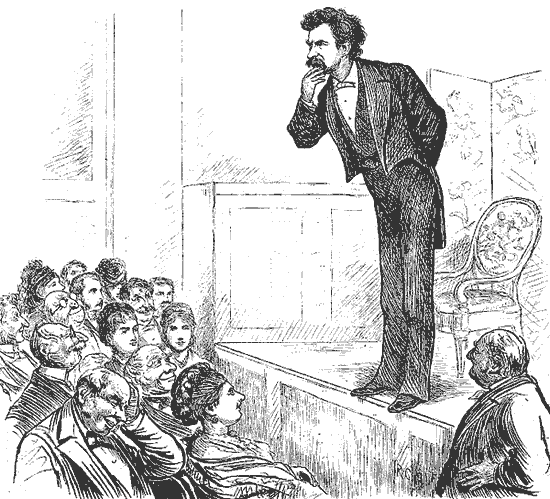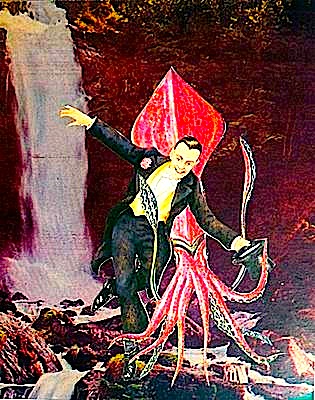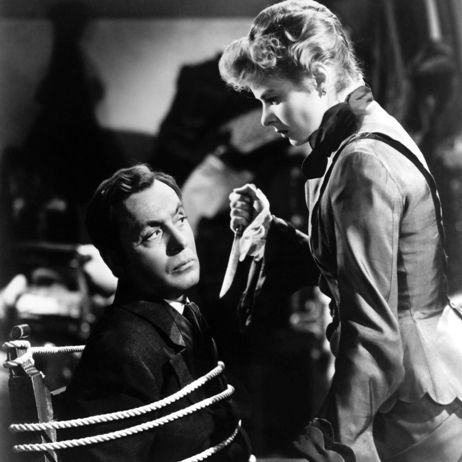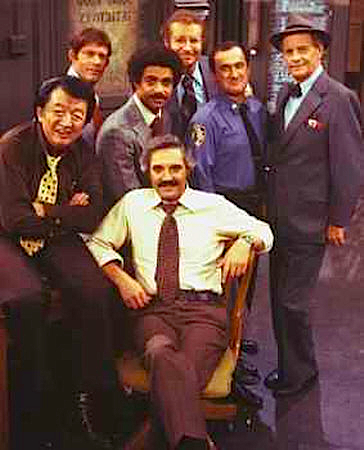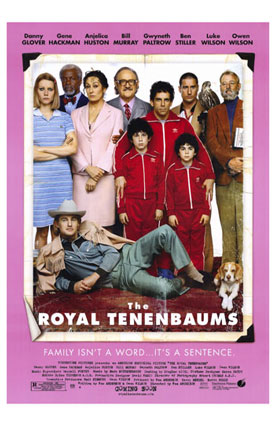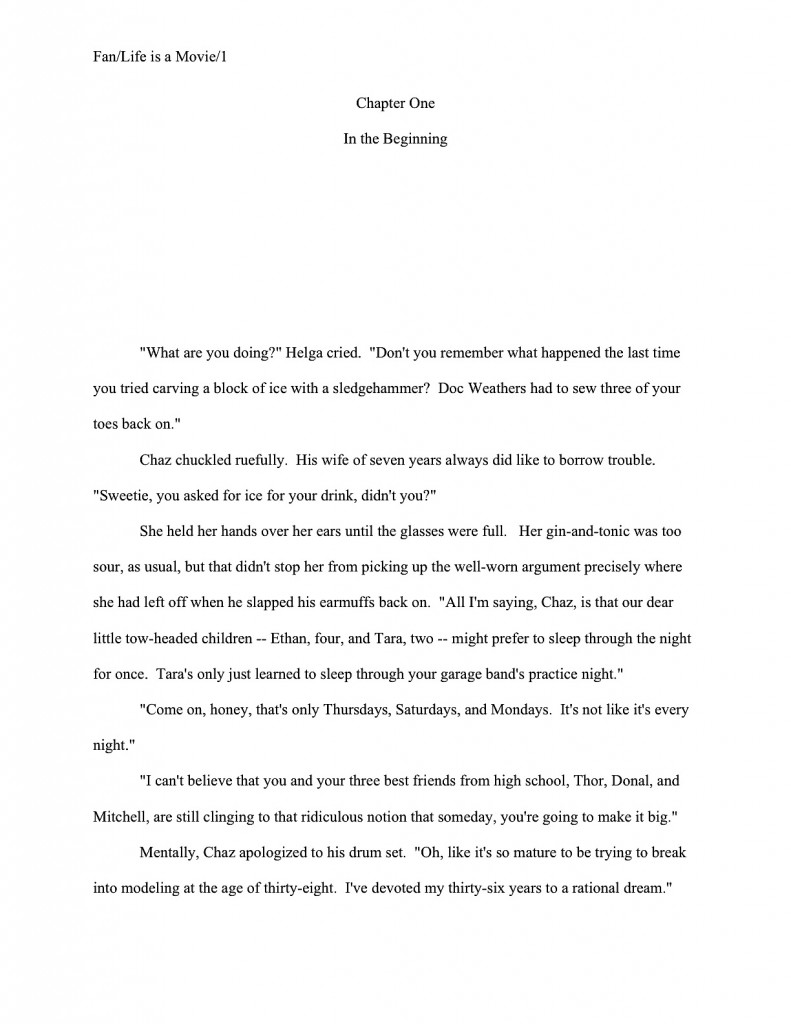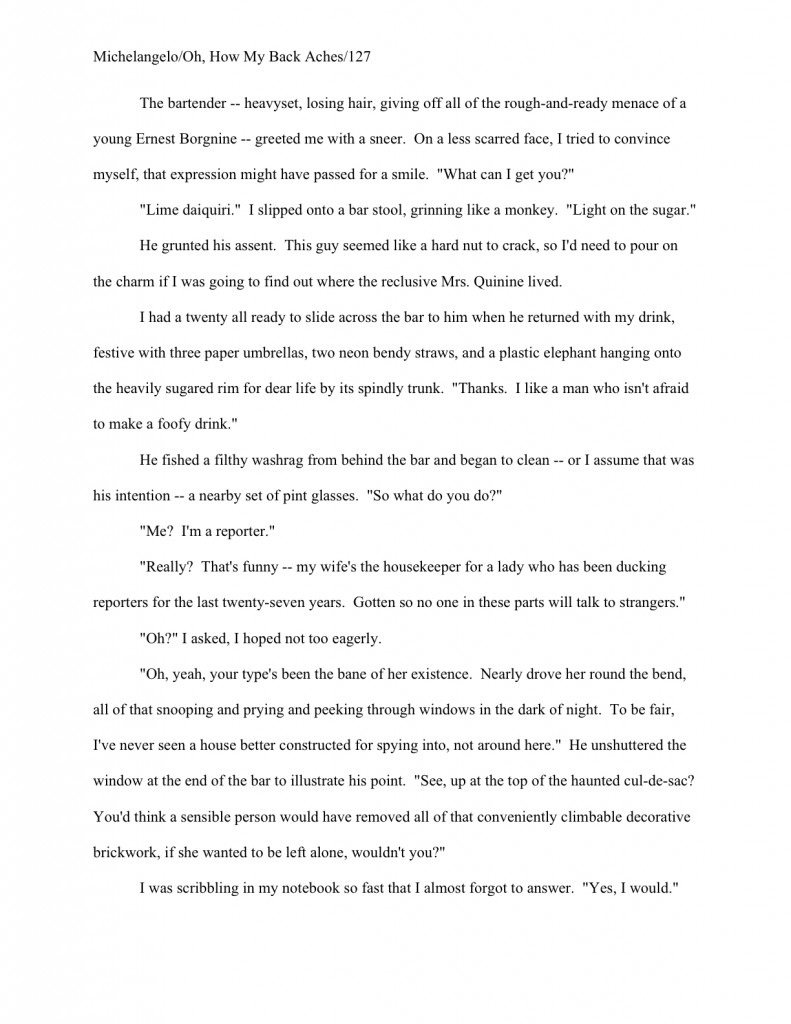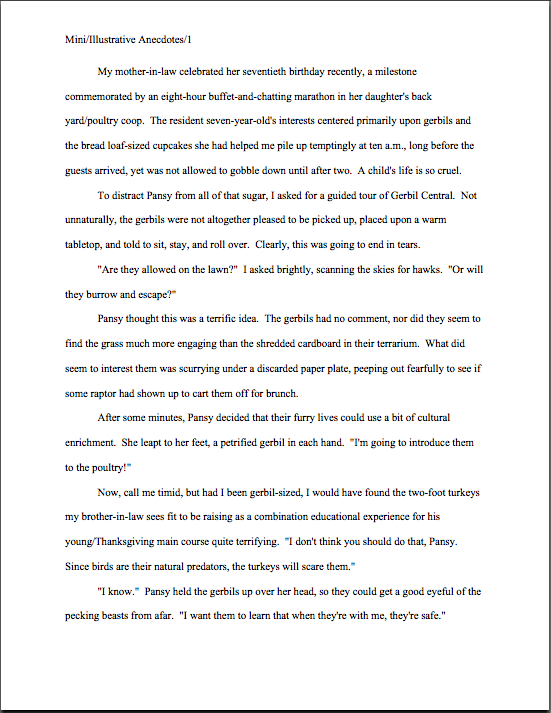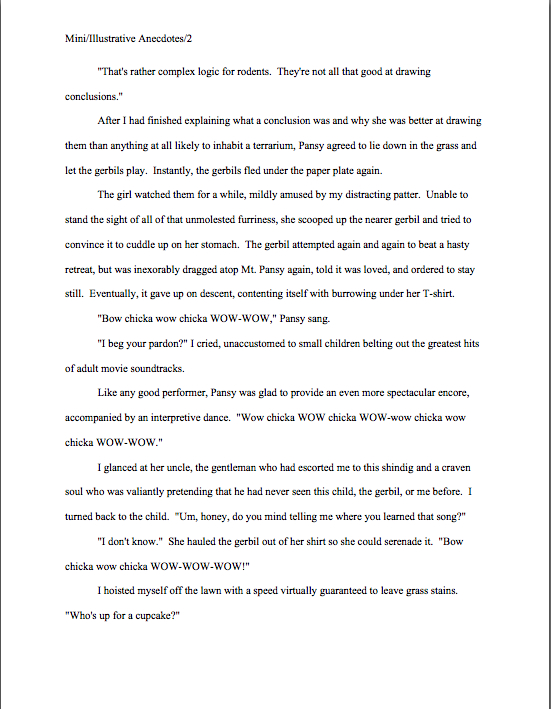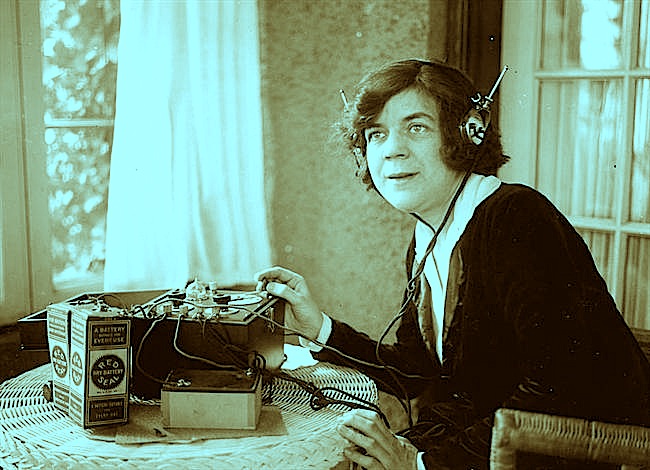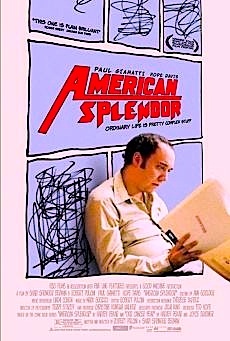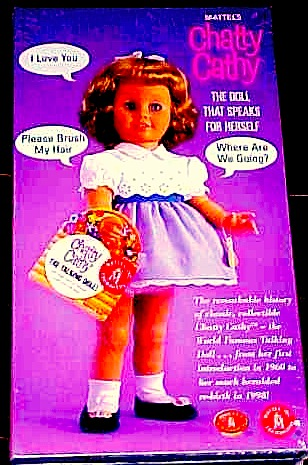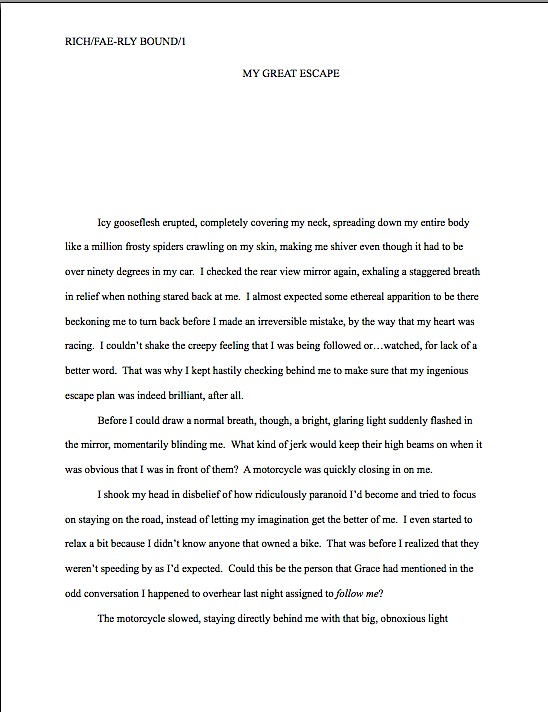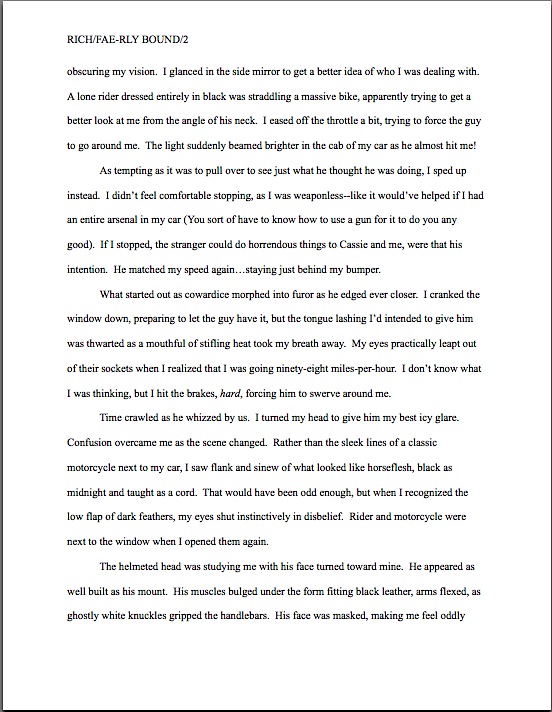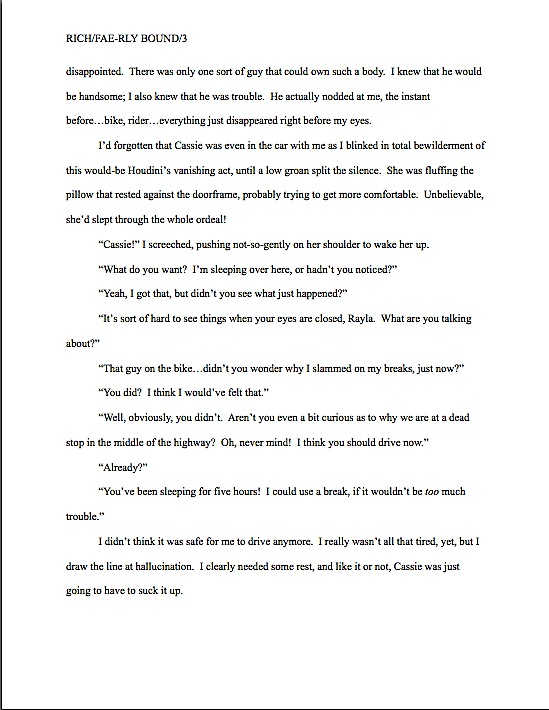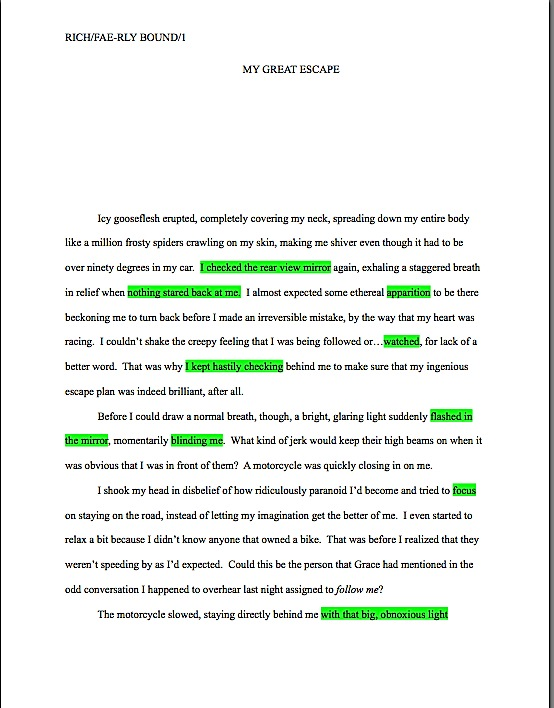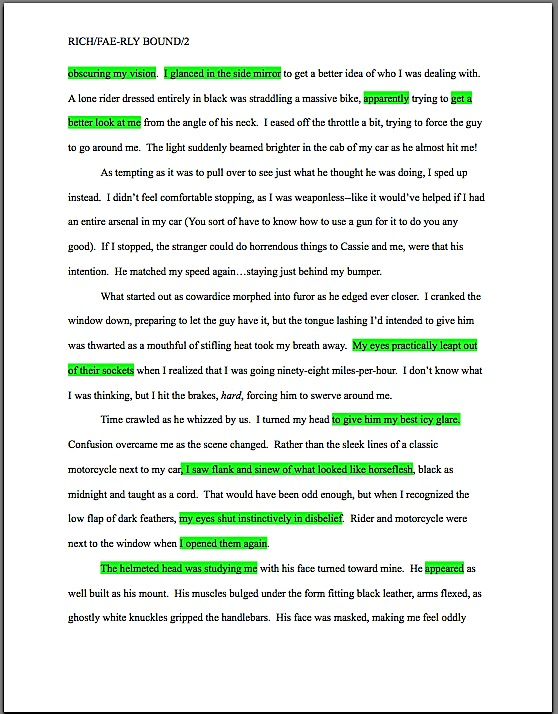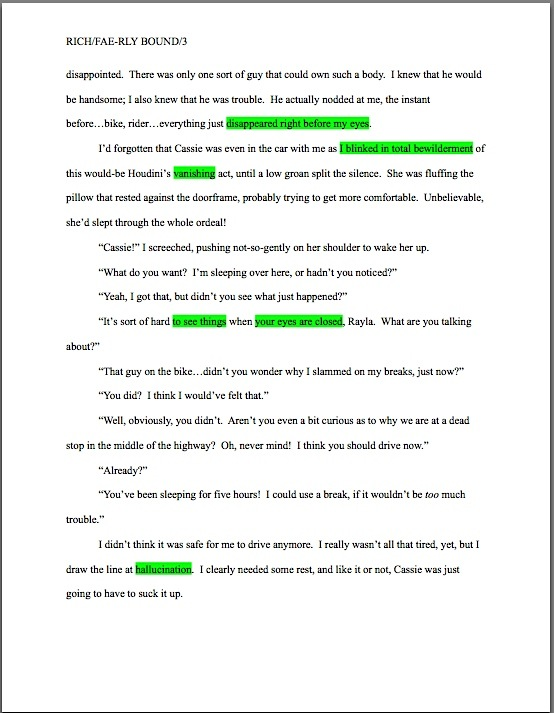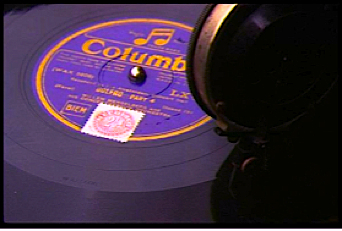
For those of you who haven’t joined us for a week or two, I’ve been busy spending my doctor-ordered take-it-easy-on-the-hands time by re-running a few older posts. Specifically, posts at least marginally related to the topic we were discussing when a car crash so rudely interrupted us: writing and revising dialogue so it rings true, adds to the story, and entertains the reader.
Or, to translate all that into the negative terms in which professional readers tend to critique work, so it doesn’t seem contrived, isn’t gratuitous, and prevents the reader from falling into the deep, refreshing slumber so often induced by dialogue ripped from real life.
To that end, I shall be repeating today the two tactics that worked so well (if I do say so myself) last time. First, I’m going to import material from that still most visited of my archival series, Seeing Submissions From the Other Side of the Desk, a lighthearted romp through dozens and dozens of reasons that our old pal, Millicent the agency screener, might feel compelled to reject a submission on page 1. Second, rather than re-run the dialogue-related posts in that series individually, I shall mash a couple together and add a bit more material, just to keep things interesting for those of you who were hanging around Author! Author! a year and a half ago.
So is it a re-run, if it is no precisely as it was the first time around? You tell me.
Enjoy!
As I may have mentioned before in this forum, Hollywood narration (dialogue wherein characters telling one another things they already know purely for the purpose of letting the reader know them, too) tends to annoy the dickens out of your garden-variety agency screener. Not merely because it is so common — and believe me, it is: TV and movie scripts abound with this sort of dialogue, which in turn influences both how people speak and what writers hear — but because it’s kind of an underhanded way of introducing backstory.
In a script, it’s understandable, as film has only sound and sight to tell a story. But a book has all kinds of narrative possibilities, right?
There was a sterling example of a VERY common subgenus of Hollywood narration read at the agents’ forum from which I derived the list of pet peeves we’ve been discussing. It was apparently a mystery that opened with the mother of a recently-recovered kidnap victim badgering the detective who was handling the case to find the kidnapper, pronto. My, but Mom was informative: within the course of roughly ten lines of back-and-forth dialogue, she filled in the detective on the entire background of the case.
Because, naturally, as the primary investigator, he would have no recollection of anything associated with it. (Maybe he was suffering from amnesia; having heard only the first page, I couldn’t tell you.) And, equally naturally, she insisted upon being brought in to collaborate on the investigation.
The agents on the panel tore it to pieces. Actually, the panelists’ reaction to this piece was fascinating, because every time one of them started to wind down his or her critique of it, another found yet more reason to object to it. Among the objections:
*The characters are telling one another things they already know.
*The opening scene was almost entirely dialogue, without giving the reader a sense of place or character.
*This scene has been in a LOT of books and movies. (Hey, blame Dashiell Hammett.)
*”I’ve never understood why third parties in mysteries always want to investigate the crimes themselves.” (I’m guessing that the agent who said this doesn’t represent a whole lot of cozy mysteries.)
*(After a slight lull in the bloodbath.) “If the kid is back safely after the kidnapping, why should we care?”
Brutal, eh, for less than a single page of dialogue? If you learn nothing else from this series, please take away this one thing: agency screeners virtually never cut any submission any slack. That opening page needs to SCREAM excellence.
So it would really behoove you to check your dialogue-based opening scenes very, very carefully to make sure that they are saying PRECISELY what you want them to say about you as a writer.
What can happen if an aspiring writer just assumes that what he’s got in mind is what Millicent will take away from the page? Well, let me put it this way: the writer who penned the opening I’ve just described– a gentle lady who had waited a year to be able to submit her opening page to this forum, I later learned — did not laugh along with the judges. She sat there, open-mouthed and blushing furiously, obviously stunned that anyone could read her innocent page 1 in such a manner.
Why did she feel so blindsided? Well, if I had to guess — and I do! I do! — it was probably because her opening gambit was one she had seen so often in the openings of TV shows, movies, and yes, even books.
Wait, where have I heard that before?
Seriously, this sub-species of Hollywood narration can be very hard for self-editors to catch. Take, for instance, the following example. (And if you can’t take it because the image is so small, try increasing the size by holding down the COMMAND key while pressing +.)
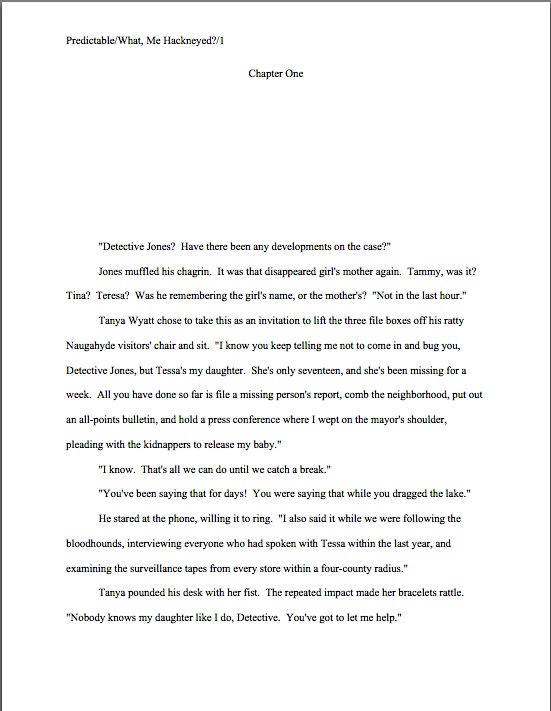
While you were reading that little gem, did you think at least twice, Gee, is there a particular reason that the reader needs to be told all of this backstory on page 1? If so, congratulations: Millicent would have had the same thought. By the middle of paragraph 3.
But be honest now, campers: if you had encountered that page in a critique group yesterday, would you instantly have tapped its author on the shoulder and whispered, “Dear friend, what you have there is a classic example of Hollywood narration, and I implore you to reconsider opening your book in this manner?” Or would you simply have admired how quickly and economically the writer worked in all of that backstory?
The vast majority of aspiring writers would have opted for the latter. Just so you know, however, Millicent would appreciate it if the next time any of you should find yourself in this situation, you would start tapping some shoulders.
Why? Because she sees this sort of opening so very, very often. Which brings me to rejection reason #30: over-use of dialogue in the name of realism.
At the risk of dropping the needle on a broken record (have your grandparents explain that metaphor to you, children), real-life dialogue tends to be very repetitious, self-referential, and, frankly, not something that would tend to move a plot along. But in defense of realism, real-life dialogue seldom resembles Hollywood narration, either. If you’re in conversation with someone with whom you speak quite frequently, you will use shared metaphors that might not make sense to an outside observer, but you’re not very likely to be discussing anything crucial to the plot of your life over coffee with a coworker.
And even if you ARE, unlike a conversation in a book, where much matter can be compressed into a single exchange, there’s just not a whole lot of incentive in real life for the stakes to be high enough to settle major life decisions within just a couple of minutes’ worth of highly relevant dialogue. Nor are you likely to import lovely language or trenchant symbolism that enlightens the reader about the human condition. It’s not even all that likely to be entertaining to a third party.
It’s just talk, usually, something people do to lubricate relationships and fill time. I’m all for relationship-lubrication on the page, but time-filling can be deadly, especially on page 1 of a book. Move it along.
When talkers do fill one another in on personal backstory, it’s usually in the form of specific anecdotes (“When I was seventeen, I had just put on my favorite record when a condor flew into my bedroom…”) or personalized summaries of larger events (“I got married in the year the condors carried off my little brother…”), rather than in Hollywood narration-type generalities (“When I was young, condors were the number one municipal problem here in Ridgedale, the pleasant small town where you and I both grew up, Tony. Remember how often the black wings used to blot out the sun? Why, I was just reminding my wife, Martha, about how dark it was on our wedding day. Remember, dear? How you screamed as the black, black birds carried our ring bearer — my brother and your fishing buddy, Tony — off into the wild blue yonder…”
See the difference? If not, I’m sure Tony would be happy to go over your collective past with you a few more times.
Typically, at this juncture, I blithely suggest that writers enamored of the idea of reproducing dialogue precisely as it is heard in real life try a little experiment: sit in a crowded café for two hours, jotting down overheard conversations verbatim. Don’t fill in any logical gaps; reproduce it as is. Afterward, go home and type up those conversations as scenes, using ONLY the dialogue actually heard.
If you can complete the second part of that exercise without falling into a profound slumber, you either have an unusually high threshold for boredom or a great affection for the mundane. Either way, have you considered a career as an agency screener, where these traits would be positive boons?
It’s highly unlikely that you would be able to get the result of this exercise past Millicent, either as dialogue or as narrative. In professional writing, merely sounding REAL is not enough; a manuscript must also be entertaining.
So here’s a radical notion for all of you revisers out there: why don’t you edit your opening pages with an eye toward entertaining Millicent, as well as future readers, rather than using them merely as a medium for backstory?
I heard half of you groaning. Yes, oh groaners, your surmise is correct: I am indeed about to tell you that a savvy reviser should pay as much attention to word, phrase, and concept repetition in dialogue as in narrative paragraphs.
Yes, Virginia, even if your work happens to be literary fiction, if it’s book-length. Slice-of-life pieces can be quite effective IF they are short — but frankly, in my opinion, most of what goes on in the real world doesn’t rise to the standards of literature.
Far, far better to apply your unique worldview and scintillating ability with words to create something BETTER than reality, I say. The same goes for dialogue.
And yes, now that you mention it, that will mean a good deal more revision for most writers. Feel free to groan again.
Some of you are already reaching for your BUT PEOPLE REALLY TALK LIKE THAT! picket signs, aren’t you? That’s not too surprising. Many aspiring writers consciously strive for prose that echoes the kind of conversational rhythms and structures one hears every day, particularly when they are penning first-person or present-tense narratives. “I want it to sound real,” they say with engaging earnestness. “My goal is to hold, as ’twere, the mirror up to nature.”
Unfortunately, from Millicent’s perspective, most of these writers don’t realize just how widespread this particular goal is — or that much real-life conversation would be either deadly dull, logically incoherent, or at minimum not literarily interesting transferred directly to the printed page.
Why? Chant it with me now, long-time readers of this blog: because real-life speakers repeat both words and sentence structures to an extent that would make even the most patient reader rip her hair out at the roots in frustration.
If this sounds vaguely familiar, it’s probably because I spoke earlier in this series about how little Millicent appreciates repetition of any kind; I also rattled on a bit last time about how conceptually repetitious most real-life dialogue tends to be. But today, I want to talk about repetition on a smaller scale, within the actual writing.
As I have pointed out before, the single most common word appearing in submissions in every book category is and. Leaning on this multi-purpose word can lead to run-on sentences, dull action sequences, and contracting the bubonic plague.
Well, okay, perhaps not the last. But the results still aren’t pretty, from Millicent’s point of view.
You would not believe, for instance, just how often the sentence structure, X happened and Y happened turns up in dialogue. From a hold-the-mirror-up-to-nature point of view, that’s completely understandable, because it’s structure that speakers use all the time. Even when writers are constructing narrative rather than dialogue, they tend to find this structure appealing: like stringing together sentences beginning with conjunctions, it artificially creates the impression conversation-like flow, as in:
I woke up the next morning and poisoned my husband’s cornflakes.
See? Chatty, casual: the way your local poisoner is very likely to say it to her next-door neighbor, right? In a single sentence, it makes for a rather likable voice.
If this structure is used sparingly, it can work very well indeed — but as any professional reader who has been at it a while would be delighted to tell you, its advocates seldom seem to be able to restrain themselves. Let’s take a peek at several sentences of this type in a row, to see why it might annoy your garden-variety Millicent at the end of a long, hard day of rejection:
Esmeralda blanched and placed her lily-white hand upon her swiftly-beating heart. Rolando nodded with satisfaction and strode toward her, grinning. She grabbed a poker from next to the fire and glanced around for an escape. He chortled villainously and continued to move closer.
See what I mean? Although each of these sentences is in fact grammatically correct, and this structure reads as though it is merely echoing common spoken English, it’s also pretty much the least interesting way to present the two acts in each sentence: the and is, after all, simply replacing the period that could logically separate each of these actions.
By contrast, take a look at how varying the sentence structure and adding the odd gerund livens things up:
Esmeralda blanched, her lily-white hand clutching her swiftly-beating heart. Rolando strode toward her, grinning. She grabbed a poker from next to the fire and glanced around for an escape. He chortled villainously, moving closer every second.
Easier to read, isn’t it? Admittedly, the prose is still pretty purple — or at least flushing lilac — but at least the paragraph is no longer jumping up and down, screaming, “My author knows only one way to structure a sentence!”
Lest any of you just thought, “Well, all Millicent would have to do is read on to the next paragraph” (or next page, or next chapter) “to discover that I know a whole lot of ways to structure a sentence; I’m not going to worry about that,” may I remind you of one of the most startling truths divulged in this series, that most manuscripts get rejected on page 1? If the opening paragraphs of a submission are structurally repetitious, how likely is it that she’s going to keep reading to find out if the writer shakes things up a little later on?
The sad fact is, most agents, editors, and contest judges would not, alas, at least while perusing a manuscript by an author with whom they do not already enjoy a professional relationship. They tend to have a very low tolerance for over-use of this particular sentence structure.
Seriously. I’ve seen pens poked through manuscripts at the third instance of an X happened and Y happenedsentence within half a page. (See why I felt this issue was important enough to interrupt our review of the Idol list to cover?) At minimum, it would be very much in your submission’s best interest to ferret out over-use of the word and.
So while you are going over your first page with a fine-toothed comb in the wake of this series anyway, why not identify and considering reworking ANY sentence in which and appears more than once? Chances are high that such a sentence will be a run-on, in any case:
In evading the police, Zelda ran down the Metro stairs and out onto the platform and into the nearest train.
This is a classic run-on: too much information crammed into a single sentence, facilitated by those pesky conjunctions. Yes, people actually do say things like this in real life, but how much do you think the realism of this sentence is going to help its author get a manuscript past Millicent?
Uh-huh. Good writing matters in dialogue every bit as much as in narration. It’s merely harder to make sound realistic.
Some writers, of course, elect to include run-on sentences deliberately in their work, for specific effect: to make the narrator sound less literate, for instance, or more childlike, or to emphasize the length of a list of actions the protagonist has to take to achieve a goal. Or sometimes, the point is to increase the comic value of a scene by the speed with which it is described, as in this excerpt from Stella Gibbons’ classic comedy, COLD COMFORT FARM:
He had told Flora all about his slim, expensive mistress, Lily, who made boring scenes and took up the time and energy which he would much sooner have spent with his wife, but he had to have Lily, because in Beverly Hills, if you did not have a mistress, people thought you were rather queer, and if, on the other hand, you spend all your time with your wife, and were quite firm about it, and said that you liked your wife, and, anyway, why the hell shouldn’t you, the papers came out with repulsive articles headed “Hollywood Czar’s Domestic Bliss,” and you had to supply them with pictures of your wife pouring your morning chocolate and watering the ferns.
So there was no way out of it, Mr. Neck said.
Quite the sentence, eh? (Not the second, silly — the first.)
I’m going to part company with pretty much every other editor in the world for a moment and say that I think that a writer can get away with this sort of run-on every once in a while, under three very strict conditions — and no, none of them is optional to observe:
(1) IF it serves a very specific narrative purpose that could not be achieved in any other manner (in this example, to convey the impression that Mr. Neck is in the habit of launching into such diatribes on intimate topics with relative strangers at the drop of the proverbial hat),
(2) IF it achieves that purpose entirely successfully (not a foregone conclusion, by any means), AND
(3) IF the writer chooses to do this at a crucial point in the manuscript, s/he doesn’t use it elsewhere — or at least reserves the repetition of this choice for those few instances where it will have the greatest effect.
Why minimize it elsewhere? Well, as we have seen above, this device tends to create run-on sentences with and…and…and constructions, technically grammatical no-nos. YOU may be doing it deliberately, but as with any grammatical rule, many writers who do not share your acumen with language include them accidentally.
Let me ask you this: how is a speed-reading agency screener to tell the difference between a literate submitter pushing a grammatical boundary on purpose and some under-read yahoo who simply doesn’t know that run-ons are incorrect?
Usually, by noticing whether the device appears only infrequently, which implies deliberate use, or every few lines, which implies an ingrained writing habit.
I’ve sensed disgruntled rumblings out there since I mentioned point #3. “But Anne,” I hear some of you protest, “I read a great deal, and I see published literary fiction authors break this rule all the time. Doesn’t that mean that the language has changed, and people like you who go on and on about the rules of grammar are just fuddy-duddies who will be first up against the wall come the literary revolution?”
Whoa there, disgruntled rumblers — as I believe I have pointed out before, I invented neither the rules of grammar nor the norms of submission evaluation. If I had, every agency and publishing house would post a clear, well-explained list of standard format restrictions on its website, along with explanations of any personal reading preferences and pet peeves its staff might happen to be harboring. Millicent would be a well-paid, under-worked reader who could spend all the time she wanted with any given submission in order to give it a full and thoughtful reading, and the government would issue delightful little checks to compensate writers for all of the time they must now spend marketing their own work.
Clearly, then, these matters are not under my personal control, so kindly take me off your literary hit lists.
Even in literary fiction, it’s rather dangerous to include grammatically incorrect sentences in a submission. To someone who hasn’t read more of your work than the first few pages of your manuscript, it’s impossible to tell whether you are breaking the normal rules of grammar in order to create a specific effect, or because you just don’t know the rule. If an agency screener concludes that it’s the latter, she’s going to reject the manuscript, almost invariably.
Thus, unless you are getting a valuable effect out of a foray into the ungrammatical, it’s best to save your few opportunities to do so intentionally for when it serves you best. At the very least, make sure that two such sentences NEVER appear back-to-back, to avoid your submission’s coming across as the work of — gasp! — a habitual runner-on.
Sometimes repeated ands work rhythmically, but to an agent or editor, a manuscript that employs X happened and Y happened as its default sentence structure it just starts to read like uncomplicated writing — which makes it less appealing to the pros.
The other common conclusion trained eyes often draw from over-use of this technique smacks of the narrative’s trying to rush through an otherwise not very interesting series of events — which, if you’ve been paying attention throughout this series, should automatically make you cringe at the idea of boring Millicent.
And honestly, is a statement like Georgette ran down the stairs and out the station door, then she made a sharp left at the corner, proceeded a hundred yards past the fruit and flower stands, now at four o’clock sadly depleted, and dashed to the waiting taxi worth the risk?
This kind of dismissive reading is not always a fair assessment of an and-ridden text, of course. But when you do find patches of ands in your text, step back and ask yourself honestly: “Do I really NEED to tell the reader this so tersely — or all within a single sentence? Or, indeed, at all?”
“Perhaps,” (you’re still speaking to yourself here, in case you were wondering, despite the fact that most Millicents find soliloquizing protagonists a touch annoying) “I could find a way that I could make the telling more interesting by adding more detail? I notice by reading back over the relevant paragraphs that my X happened and Y happened sentences tend to be light on telling specifics.”
My, you’re starting to think like Millicent. Do keep it up.
Since your revision eye is getting so sophisticated, let’s consider the opposite possibility: in paragraphs where ands abound (or, sacre bleu, sentences!), are you rushing through the action of the scene too quickly for the reader to enjoy it? Are some of those overloaded sentences cramming four or five genuinely exciting actions together — and don’t some of these actions deserve their own sentences?
Or, to put it a bit more bluntly, is the repeated use of and in fact your manuscript’s way of saying COME BACK AND FLESH THIS OUT LATER?
C’mon, admit it — almost every writer has resorted to this device at the end of a long writing day, haven’t we? Or when we have a necessary-but-dull piece of business that we want to gloss over in a hurry? Or did you think you were the only writer in the history of the world who did this?
Don’t be so hard on yourself — writers do this all the time. When the point is just to get lines down on a page — or to get a storyline down before the inspiration fades — X happened and Y happened and Z happened is arguably the quickest way to do it.
It’s a perfectly acceptable time-saving strategy for a first draft — as long as you remember to go back later and vary the sentence structure. Oh, and to make sure that you’re showing in that passage, not telling.
When we forget to rework these flash-written paragraphs, the results may be a bit grim. Relying heavily on the and construction tends to flatten the highs and lows of a story: within them, actions come across as parts of a list, rather than as a sequence in which all the parts are important.
Which — you guessed it — encourages the reader to gloss over them quickly, under the mistaken impression that these events are being presented in list form because they are necessary to the plot, but none is interesting enough to sustain an entire sentence.
Which is not exactly the response you want your sentences to evoke from Millicent, right?
When in doubt, revise to minimize the ands. I hate to come down unfairly on any grammatically correct sentence, but the fact is, the X happened and Y happened structure is just not considered very literary in the business. So the automatic assumption if it shows up too much is that the material covered by it is to be read for content, rather than beauty of prose.
To quote Millicent’s real-life dialogue: “Next!”
I would prefer to see your submissions getting long, luxurious readings, on the whole, not getting knocked out of consideration over technicalities. I’m funny that way. Keep up the good work!
